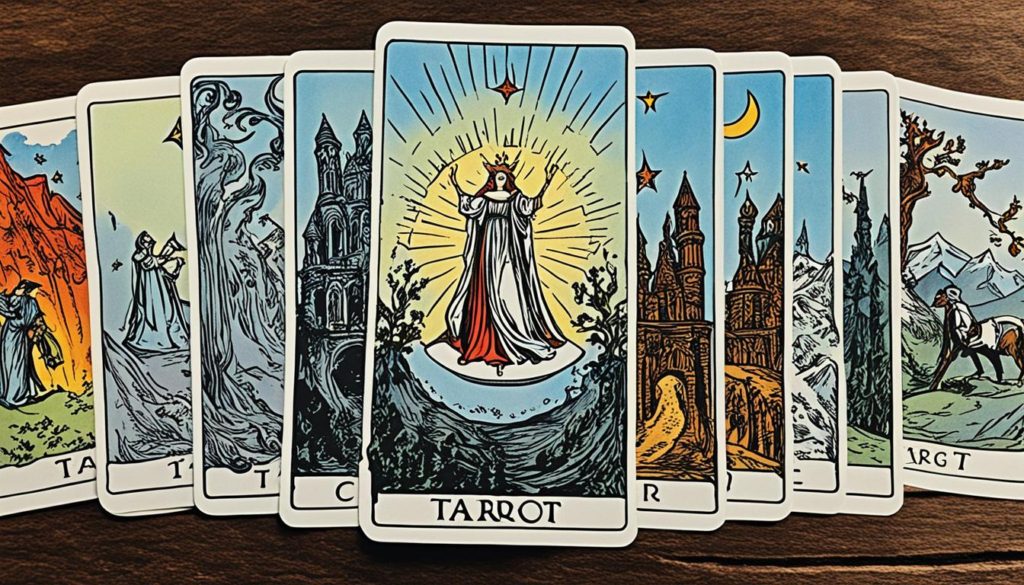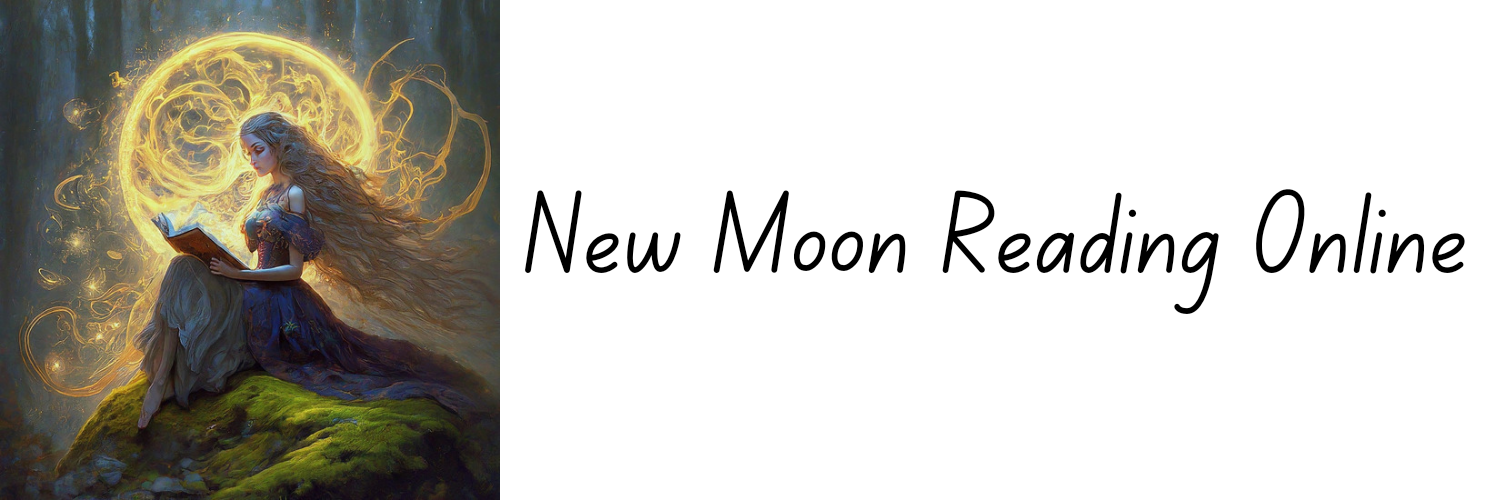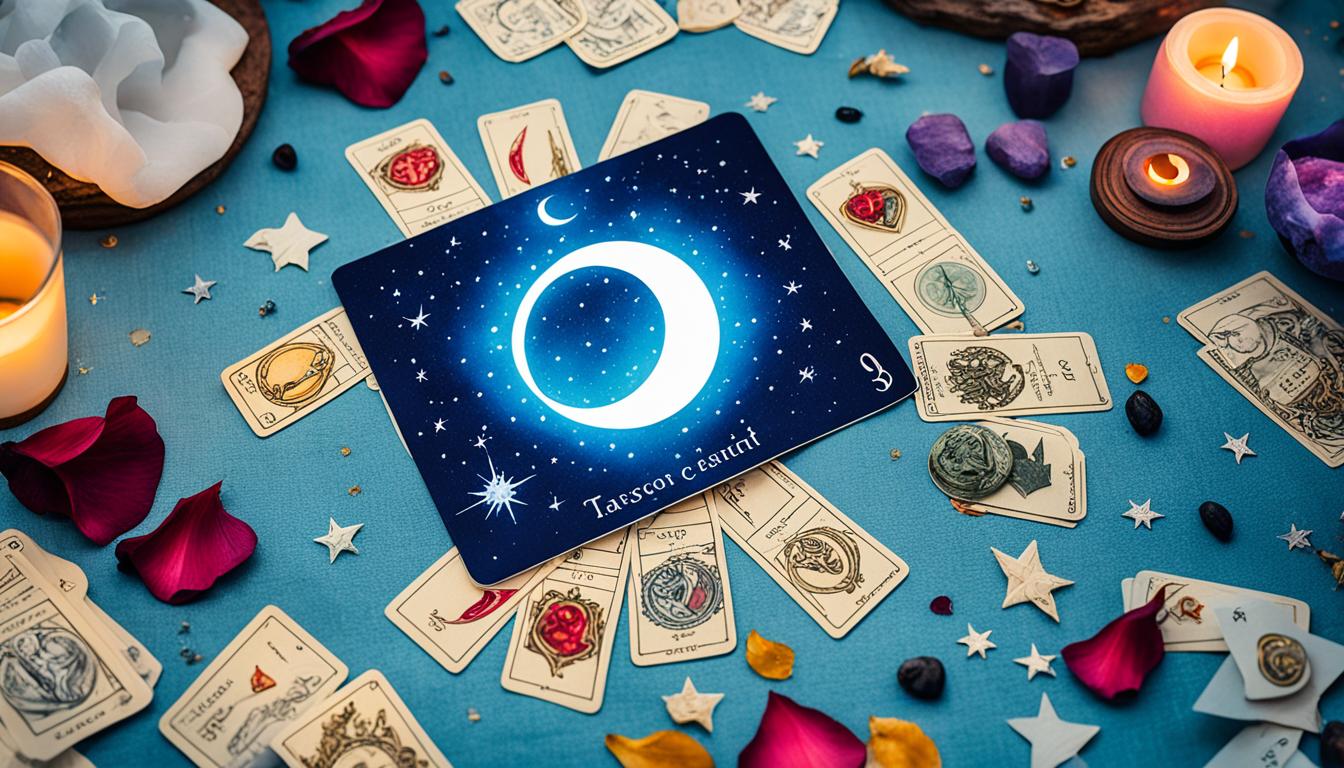Are you seeking guidance through a New Moon reading? As you delve into the world of astrology and divination, have you ever considered the ethical implications of choosing a reader?
When it comes to New Moon Readings, it’s important to select a reader who aligns with your values and beliefs. By doing so, you can ensure an authentic and meaningful experience that resonates with your personal journey. But how do you find a reader who shares your ethical compass?
Let’s explore the significance of ethical considerations in New Moon Readings and discover how you can choose a reader who not only provides accurate insights but also respects your values throughout the divination process.
Key Takeaways:
- Choosing a reader for a New Moon Reading is crucial for an authentic and meaningful experience.
- Ethical New Moon Readings prioritize your well-being and respect your values.
- Find a reader who shares your ethical compass to enhance your personal and spiritual growth.
- Consider the reader’s approach, beliefs, and values before making your decision.
- By aligning with an ethical reader, you engage in New Moon Readings that honor your journey.
Understanding Astrological Signs and Personalities
Astrology is a complex practice that takes into account various factors, including the placement of planets and the relationships between them. While many people are familiar with their sun sign, there are other important astrological signs that shape our personalities, such as the moon sign and ascendant sign.
The moon sign reflects our natural disposition and emotional responses. It is associated with our inner self and how we navigate our emotions. For example, someone with a moon sign in Cancer may be nurturing and intuitive, while someone with a moon sign in Aries may be more impulsive and energetic.
The ascendant sign, also known as the rising sign, represents how we authentically express ourselves. It is associated with our outward behavior and how we interact with the world. For instance, someone with an ascendant sign in Libra may be diplomatic and charming, while someone with an ascendant sign in Capricorn may be disciplined and ambitious.
Understanding these astrological signs can provide valuable insights into our personalities and help us recognize our strengths, challenges, and potential areas for growth.
When it comes to choosing a New Moon Reader, these signs can play a significant role. Aligning with a reader who understands and resonates with our astrological signs can enhance the accuracy and relevance of the reading. By selecting a reader who aligns with our values and beliefs, we can ensure a more personalized and meaningful experience.
Exploring our astrological signs offers a deeper understanding of ourselves and our unique personalities. Whether we resonate more with our moon sign or our ascendant sign, each sign contributes to our overall identity. By embracing and working with these signs, we can navigate life with greater self-awareness and make choices that align with our authentic selves.
The Influence of Astrological Signs on Famous Personalities
Examining the astrological signs of famous personalities can provide further understanding of how different signs influence individuals. For example, Lady Gaga has a Gemini ascendant, which is reflected in her open and extroverted thoughts. However, her Scorpio moon indicates a history of pain and transformation, which has shaped her into a strong advocate for marginalized communities. Similarly, Kylie Jenner’s Capricorn rising sign points to challenges with wealth and status, while her Leo sun demonstrates her desire for attention and success. Beyoncé’s Scorpio moon reflects her shy and introverted nature, while her Libra rising sign showcases her artistic self-expression and social confidence. These examples highlight how astrology can provide insights into the personalities of famous individuals.

Understanding the astrological signs of famous personalities can offer fascinating insights into their character traits, motivations, and life experiences. By exploring the influence of astrology on these individuals, we can gain a deeper appreciation for the complexities of human nature and the diversity of personalities shaped by the stars.
The Role of the Shadow Card in Tarot Readings
In tarot readings, the shadow card holds a significant place. It refers to the card at the bottom of the deck that represents an individual’s innermost emotions and fears. This card goes beyond the surface and dives deep to provide additional insight and clarification to the overall reading.
Just as shadows follow us wherever we go, the shadow card follows the entire spread, shedding light on the hidden aspects of our lives. It’s like reading the last page of a book first, allowing us to glimpse where the journey is headed.
“The shadow card acts as a portal to our innermost selves, revealing the fears and emotions that shape our experiences. It adds depth and nuance to the reading, offering a clearer understanding of our subconscious desires and hidden challenges.”
By acknowledging and embracing our innermost emotions and fears, we open the door to self-awareness and growth. The shadow card serves as a key that unlocks a deeper level of understanding, allowing us to confront and overcome our inner demons.
| Key Points | Benefits of the Shadow Card |
|---|---|
| 1. Insights into Innermost Emotions | 1. Provides clarity on hidden emotions and desires |
| 2. Guidance for Overcoming Fears | 2. Offers guidance to confront and overcome fears |
| 3. Enhanced Divination Process | 3. Adds depth and meaning to the overall reading |
The shadow card plays an integral role in the divination process, offering valuable guidance and a deeper understanding of ourselves. By embracing the shadow, we can embark on a journey of self-discovery and transformation.
Using the Bottom Card of the Tarot Deck for Clarification
In addition to the shadow card, the bottom card of the tarot deck can also be used for clarification in readings. When there is uncertainty or a need for further insight, drawing additional cards or laying out a new spread can provide the necessary clarity.
While the traditional Celtic Cross spread consists of ten cards, there are no strict rules when it comes to tarot readings. Additional cards can be drawn to explore specific questions or to delve deeper into a particular area of concern. Incorporating the bottom card or drawing extra cards allows for a more comprehensive and detailed reading.
By examining the additional cards drawn, the tarot reader can gain a clearer understanding of the situation and provide deeper insights. Just as a detective uncovers clues to solve a mystery, drawing more cards helps to unravel the layers of meaning within the reading. Each card adds an extra piece to the puzzle, painting a more complete picture.
It’s important to note that when drawing additional cards, one should approach the process with an open mind and remain receptive to the messages of the tarot. Each card holds its own wisdom and symbolism, contributing to the overall interpretation. The bottom card acts as an anchor, grounding the reading and providing a focal point for clarification.
When interpreting the cards, the reader considers the individual meaning of each card, as well as the relationship between them. The bottom card, in particular, can shed light on the themes and energies present in the reading.
“Drawing additional cards and incorporating the bottom card allows me to explore different angles and gain a deeper understanding of the querent’s situation. It’s like peeling back the layers of an onion, revealing hidden truths and insights.” – Tarot Reader
By drawing extra cards and paying attention to the bottom card, the tarot reader can provide a more nuanced and insightful interpretation. This process allows for flexibility and adaptability, tailored to the specific needs of the querent.
Sample Tarot Reading with Additional Cards
| Card Position | Card Description |
|---|---|
| 1 | The Magician |
| 2 | The Emperor |
| 3 | The High Priestess |
| 4 | The Lovers |
| 5 | The Chariot |
| 6 | The Fool |
| 7 | The Hermit |
| 8 | The Tower |
| 9 | The Star |
| 10 | The Moon |
| Bottom Card | The Wheel of Fortune |
| Additional Card 1 | The Sun |
In this example, the traditional Celtic Cross spread is used with ten cards. The bottom card is The Wheel of Fortune. An additional card, The Sun, is drawn for clarification on the querent’s question about their future.

The Wheel of Fortune as the bottom card indicates that there are external forces at play, representing changes and cycles in the querent’s life. The addition of The Sun card suggests a positive outcome, with clarity and success on the horizon.
By incorporating the bottom card and drawing an extra card, the reader can provide a more nuanced interpretation, offering the querent a deeper understanding of their circumstances and potential outcomes.
Personal Connection to the Bottom Card in Tarot Readings
When it comes to tarot readings, there is a fascinating phenomenon that many readers, both professional and personal, experience: a personal connection to the bottom card. This unique bond between the reader and the bottom card adds depth and meaning to the tarot reading process.
For some readers, this connection may originate from personal beliefs or experiences. Just as some individuals have superstitions or unique reading habits, certain tarot readers feel drawn to checking the bottom card due to a family tradition or a personal quirk. It becomes a ritual, a way to tap into their intuition and connect with the unseen forces guiding the reading.
“The personal connection to the bottom card is like having a secret ally in the tarot deck, a constant companion throughout the reading journey.”
The bottom card acts as a beacon, shedding light on the path and providing additional guidance for the reader. It is believed to hold a special message, offering insights and revealing hidden layers of meaning. Some readers may even consider it a mirror reflecting their own energies or a silent partner in their divinatory practice.
Connecting with the Bottom Card: A Personal Journey
My personal journey with the bottom card started when I first discovered the world of tarot. As a novice reader, I was captivated by the intricacies and symbolism of each card. However, it was the bottom card that held a mysterious allure for me.
Over time, I began to pay closer attention to this card, allowing it to become an integral part of my readings. I found that by connecting with this card, I gained deeper insights and a profound understanding of the overarching message conveyed by the spread.
For me, the bottom card serves as a reminder to trust my intuition and embrace the synchronicities unfolding in my life. It acts as a mirror, reflecting back the energies and themes that are most relevant to my current journey. This personal connection allows me to provide my clients with a more authentic and intuitive reading experience.
Embracing the Personal Connection
Embracing the personal connection to the bottom card is a deeply enriching experience for both the reader and the querent. It adds a level of authenticity and meaning to the reading, fostering a stronger connection between the two parties.
As readers, acknowledging and honoring this personal connection allows us to tap into our intuition and channel the guidance provided by the cards. It helps us create a safe and sacred space for our clients, ensuring they receive the insights they seek. By embracing this connection, we can deliver tarot readings that are not only accurate but also deeply resonant.
So, the next time you embark on a tarot reading, remember to pay attention to the bottom card. Allow yourself to form a personal connection with it and let it guide you on your divinatory journey.
Through this image of the bottom card, you can catch a glimpse of the profound insights and possibilities that await you in the realm of tarot.
| Benefits of Embracing the Personal Connection: |
|---|
| 1. Enhanced intuition and connection to divine guidance |
| 2. Deeper insights and meaningful interpretations |
| 3. Stronger connection and rapport with clients |
| 4. Authentic and resonant tarot readings |
| 5. A sense of empowerment and trust in the reading process |
Ethical Tensions in Occupational Therapy Practice
Ethical tensions are an inherent aspect of occupational therapy practice, as professionals navigate diverse agendas and values within practice contexts. These tensions can lead to moral distress, professional burnout, and attrition. The field of occupational therapy has recognized the importance of addressing these ethical tensions and supporting practitioners in making decisions that align with their values.
While there has been some research on ethical challenges in healthcare, limited studies specifically focus on the conflicting allegiances that occupational therapists may experience. Understanding the nature of these tensions is crucial for improving practice and providing better support for occupational therapists.
| Ethical Tensions | Occupational Therapy Practice |
|---|---|
| Conflicting agendas and values | Navigating diverse contexts |
| Moral distress | Emotional burden on practitioners |
| Professional burnout | Negative impact on job satisfaction |
| Attrition | Loss of skilled practitioners |
Addressing ethical tensions requires a comprehensive understanding of the challenges faced by occupational therapists. By acknowledging and discussing these tensions, the profession can work towards developing strategies and guidelines that support ethical decision-making. This includes providing resources and training to empower practitioners in navigating complex ethical dilemmas.
Supporting Occupational Therapists in Decision-Making
Organizations and professional bodies play a crucial role in creating a supportive environment for occupational therapists. This can be achieved through the implementation of ethical frameworks, regular ethical reflection, and open communication channels. By encouraging practitioners to engage in ethical discussions and seek guidance when needed, ethical tensions can be better managed.
It is essential to foster a culture that values ethical decision-making and recognizes the challenges faced by occupational therapists in practice.
Additionally, ongoing education and training on ethical principles and decision-making can equip occupational therapists with the necessary knowledge and skills to navigate complex ethical situations. This includes providing opportunities for practitioners to explore case studies and engage in ethical discussions with their peers.
By addressing and actively working to alleviate ethical tensions in occupational therapy practice, the profession can promote the well-being of practitioners and ensure the delivery of high-quality care to clients. Creating a supportive and ethically conscious practice environment is crucial for the long-term sustainability and growth of occupational therapy as a profession.
Conflicting Allegiances in Occupational Therapy Practice
An exploratory study conducted in Southwestern Ontario examined the challenges of conflicting allegiances experienced by occupational therapists in their practice. The study focused on the ethical tensions that arise from balancing various allegiances, including personal values, clients, colleagues, employers, and regulatory colleges. These conflicting allegiances often create ethical challenges for occupational therapists, who must navigate complex situations while ensuring the well-being of their clients.
The study revealed that occupational therapists often find themselves torn between upholding their personal values, meeting the needs of their clients, conforming to the expectations of their colleagues and employers, and complying with the regulations set forth by their professional bodies. These conflicting allegiances can cause considerable ethical tensions, requiring occupational therapists to make difficult decisions in their practice.
In order to address these ethical tensions, it is essential for practice settings to create an environment that supports occupational therapists in navigating the various allegiances and dilemmas they face. This includes providing ongoing education, professional development, and ethical guidance to help therapists make informed decisions. The goal is to foster a culture that prioritizes client needs while also recognizing the challenges that occupational therapists encounter in balancing their allegiances.
By acknowledging and addressing these conflicting allegiances, practice settings can ensure that occupational therapists are equipped with the necessary tools and supports to make ethical decisions. This ultimately enhances the quality of care provided to clients and contributes to the overall professionalism and integrity of the occupational therapy profession.
Let’s examine a practical example to understand how conflicting allegiances can impact occupational therapy practice:
Imagine a situation where an occupational therapist is working with a client who wants to return to work following a workplace injury. The client’s employer is pressuring the therapist to expedite the client’s recovery and return to work as soon as possible. However, the therapist believes that the client needs more time to heal and recover fully before returning to work. In this scenario, the therapist’s allegiances to the client’s well-being and the ethical obligation to provide quality care conflict with the employer’s expectations. The occupational therapist must navigate this ethical tension and make a decision that prioritizes the client’s best interests while considering the demands imposed on them by their employer.
Addressing conflicting allegiances in occupational therapy practice requires ongoing reflection, ethical discussions, and the development of strategies that empower therapists to make decisions that align with their values and prioritize the needs of their clients. By fostering an ethical and supportive environment, the profession can uphold its commitment to providing high-quality care while navigating the complex ethical challenges that arise in occupational therapy practice.
| Conflicting Allegiances | Ethical Tensions | Occupational Therapy Practice |
|---|---|---|
| Competing allegiances to personal values, clients, colleagues, employers, and regulatory colleges | Ethical tensions arising from conflicting allegiances | Challenges in occupational therapy practice |
| Struggle to balance allegiances | Ethical challenges in occupational therapy | Supporting occupational therapists in decision-making |
| Creating an environment that navigates conflicting allegiances | Enhancing occupational therapy practice | Prioritizing client needs while meeting demands |
| Providing education, professional development, and ethical guidance | Sustaining ethical decision-making | Integrity and professionalism in occupational therapy |
Implications of Ethical Tensions in Occupational Therapy Practice
Ethical tensions within the field of occupational therapy have far-reaching implications for both practitioners and the profession as a whole. When occupational therapists find themselves confronted with these tensions, it can give rise to a range of negative outcomes, including moral distress, decreased professional satisfaction, burnout, and ultimately attrition from the field. The impact of these tensions extends beyond the individual therapist, as they can also compromise the quality of care provided to clients and potentially tarnish the overall reputation of the profession.
Effects on Practitioners
Occupational therapists who are unable to align their actions with their deeply held values are more prone to experiencing moral distress and a sense of internal conflict. This distress can contribute to decreased professional satisfaction and a heightened risk of burnout. The emotional toll of continuously navigating ethical tensions can lead to reduced well-being and impaired career longevity for therapists. Maintaining ethical integrity within their practice is not only crucial for the therapist’s own fulfillment but also for the long-term sustainability of the occupational therapy profession.
Impact on Client Care
When ethical tensions persist within occupational therapy practice, there is a potential for these conflicts to compromise the quality of care provided to clients. Therapists must make decisions that prioritize the well-being and best interests of their clients. However, when facing conflicting values or conflicting demands from various stakeholders, occupational therapists may find it challenging to make ethically sound choices. This could potentially result in suboptimal treatment approaches or compromises in the delivery of client-centered care. It is imperative to address these ethical tensions to ensure the provision of quality care and maintain the trust of clients and their families.
Reputation of the Profession
The ethical conduct of occupational therapists directly impacts the reputation of the profession as a whole. Clients and the general public place trust in occupational therapists to uphold ethical standards and act in the best interests of those they serve. If ethical tensions are not properly addressed and resolved, it can erode trust and confidence in the profession. Consequently, the reputation of occupational therapy as an essential healthcare discipline may be called into question. Preventing and mitigating ethical tensions within the field is not only necessary for the well-being of practitioners but also to preserve the integrity and standing of the profession in the eyes of the public.
| Implications | Description |
|---|---|
| Moral Distress | Feelings of internal conflict and distress when one’s actions do not align with personal values. |
| Decreased Professional Satisfaction | Reduced fulfillment and satisfaction in one’s occupational therapy practice. |
| Burnout | Physical, emotional, and mental exhaustion resulting from chronic work-related stress. |
| Attrition | The act of leaving or departing from the occupational therapy profession due to ethical tensions and associated challenges. |
| Compromised Client Care | A compromised ability to provide optimal care to clients, potentially resulting in suboptimal treatment approaches or compromises in client-centered care. |
| Reputation of the Profession | The overall perception and standing of the occupational therapy profession in the eyes of the public and stakeholders. |
To address these implications, it is imperative for organizations and policymakers within the field of occupational therapy to take proactive measures. This includes creating supportive environments, facilitating open communication and ethical reflection, and providing education and training in ethical decision-making. By addressing ethical tensions and supporting occupational therapists in aligning their actions with their values, the profession can strive towards enhanced well-being for its practitioners, improved client care, and an unwavering commitment to ethical standards.
Strategies for Addressing Ethical Tensions in Occupational Therapy Practice
Addressing ethical tensions in occupational therapy practice requires the implementation of various strategies. By promoting open communication and creating a supportive environment, we encourage ethical reflection and dialogue among practitioners. This fosters a culture of collaboration and encourages the sharing of diverse perspectives, enabling occupational therapists to navigate challenging situations more effectively.
Providing education and training on ethical decision-making and ethical frameworks is another crucial strategy. By empowering occupational therapists with the knowledge and tools to analyze ethical dilemmas, we enable them to make well-informed decisions that prioritize the well-being of their clients while aligning with their own values.
Professional organizations and regulatory bodies play a vital role in addressing ethical challenges within the occupational therapy profession. These entities can develop guidelines and standards that specifically address ethical tensions, providing clear frameworks for practitioners to follow. Additionally, they can offer resources and support to help occupational therapists navigate complex ethical situations.
Lastly, fostering a culture of self-care and well-being is essential for preventing moral distress and burnout among occupational therapists. By prioritizing their emotional and physical well-being, we enable them to approach ethical challenges from a place of strength and resilience.
Strategies for Addressing Ethical Tensions:
- Promote open communication and a supportive environment
- Provide education and training on ethical decision-making
- Utilize ethical frameworks for guidance
- Develop guidelines and standards
- Offer resources and support
- Foster a culture of self-care and well-being
Implementing these strategies will contribute to a profession that is committed to ethical practice and values the well-being of both practitioners and clients.
| Strategies | Benefits |
|---|---|
| Promote open communication and a supportive environment | – Encourages ethical reflection and dialogue – Facilitates collaboration and diverse perspectives |
| Provide education and training on ethical decision-making | – Empowers occupational therapists to make informed decisions – Aligns actions with values |
| Utilize ethical frameworks for guidance | – Provides a structured approach to analyzing ethical dilemmas – Ensures consistency in decision-making |
| Develop guidelines and standards | – Offers clear expectations for ethical practice – Provides a reference for practitioners |
| Offer resources and support | – Assists occupational therapists in navigating ethical challenges – Enhances professional development |
| Foster a culture of self-care and well-being | – Reduces moral distress and burnout – Enhances resilience and overall well-being |
Addressing ethical tensions in occupational therapy practice requires a multifaceted approach that involves promoting open communication, providing education and training, developing guidelines and standards, and fostering a culture of self-care. By implementing these strategies, we can create a profession that upholds strong ethical principles and prioritizes the well-being of both practitioners and clients.
Importance of Ethical New Moon Readings
Choosing a reader for a New Moon Reading who aligns with your values is crucial for an authentic and meaningful experience. Just as ethical tensions can arise in various aspects of life, they can also manifest in the realm of astrology and divination. Ethical New Moon Readings prioritize the client’s well-being and respect their values, ensuring that the reader provides accurate and insightful guidance without compromising personal ethics. By choosing an ethical reader, individuals can engage in New Moon Readings that align with their beliefs and ultimately enhance their personal and spiritual growth.
The Power of Ethical New Moon Readings
When it comes to New Moon Readings, the importance of ethical practice cannot be overstated. It is an opportunity to connect with the cosmos and gain valuable insights into our lives. However, not all readings are created equal. By choosing an ethical reader, you can ensure that the process is grounded in integrity and respect.
With ethical New Moon Readings, you are empowered to make decisions that align with your values and personal growth. The reader takes into account your unique circumstances and provides guidance that is relevant and meaningful. They prioritize your well-being, ensuring that the reading is a positive and enriching experience.
Ethical New Moon Readings prioritize the client’s well-being and respect their values, ensuring that the reader provides accurate and insightful guidance without compromising personal ethics.
Furthermore, ethical New Moon Readings promote a reciprocal relationship between the reader and the client. It is a collaboration where both parties are actively engaged in the process. The reader values your input and invites open dialogue throughout the reading. This creates a safe space for exploration and growth.
Benefits of Choosing Ethical Readers
The benefits of choosing ethical readers for New Moon Readings are numerous. Firstly, you can have confidence in the accuracy and authenticity of the guidance provided. Ethical readers adhere to a strict code of conduct, ensuring that their interpretations are grounded in knowledge and experience.
In addition, ethical readers respect your boundaries and personal beliefs. They do not impose their own agenda or biases onto the reading. Instead, they create an environment where diverse perspectives are valued and respected.
Moreover, ethical New Moon Readings foster a sense of trust and connection between the reader and the client. When you feel heard, understood, and respected, the reading becomes a transformative experience. It deepens your connection to the cosmos and aids in your personal and spiritual development.
Choosing Ethics for New Moon Readings
In order to ensure an ethical New Moon Reading, it is important to do your research and choose a reader who aligns with your values. Consider their background, experience, and testimonials from previous clients. Look for a reader who practices with integrity, honesty, and respect.
Remember, the power of New Moon Readings lies not only in the insights gained but also in the ethical framework within which they are conducted. By choosing an ethical reader, you are investing in a reading that honors your values, promotes personal growth, and provides meaningful guidance.
Choosing ethical New Moon Readings is a powerful way to engage with the cosmos and nurture your personal and spiritual growth. By prioritizing your values and well-being, these readings offer insights that resonate deeply and guide you on your journey. Embrace the transformative potential of ethical New Moon Readings and experience the profound impact they can have on your life.
Conclusion
In conclusion, ethical New Moon Readings provide individuals with the opportunity to select a reader who resonates with their values and offers genuine guidance. Whether it’s exploring astrological signs, delving into tarot readings, or navigating ethical tensions in occupational therapy practice, ethical considerations play a significant role in these realms. Understanding and addressing these tensions are vital for personal and professional growth.
By actively choosing ethical practices and practitioners, individuals can ensure that their readings and experiences align with their values, contributing to their overall well-being. Ethical New Moon Readings allow for a more authentic and meaningful connection, empowering individuals to make informed decisions based on their personal ethics.
As we continue on our journey of self-discovery and growth, it is essential to remember the importance of aligning our beliefs with our actions. By prioritizing ethical practices, we create a space where trust, respect, and integrity thrive.
FAQ
What should I consider when choosing a reader for a New Moon Reading?
When choosing a reader for a New Moon Reading, it is important to consider their alignment with your personal values and beliefs.
How do astrological signs influence our personalities?
Astrological signs, such as the moon sign and ascendant sign, reflect different aspects of our personalities and should be taken into account when choosing a New Moon Reader.
Can astrology provide insights into the personalities of famous individuals?
Yes, examining the astrological signs of famous personalities can provide further understanding of how different signs influence individuals, as seen in examples like Lady Gaga, Kylie Jenner, and Beyoncé.
What is the role of the shadow card in tarot readings?
The shadow card, which is the card at the bottom of the deck, represents an individual’s innermost emotions and fears and can provide additional insight and clarification to the overall reading.
How can the bottom card of the tarot deck be used for clarification?
The bottom card of the tarot deck can be used for clarification in readings by drawing additional cards or laying out a new spread to explore specific questions or delve deeper into a particular area of concern.
Why do readers have a personal connection to the bottom card in tarot readings?
Many readers have a personal connection to the bottom card in tarot readings due to personal beliefs, experiences, or unique reading habits, which adds depth and meaning to the reading process.
What are some ethical tensions in occupational therapy practice?
Ethical tensions in occupational therapy practice can arise from competing allegiances to personal values, clients, colleagues, employers, and regulatory colleges.
What are the implications of ethical tensions in occupational therapy practice?
Ethical tensions can lead to moral distress, decreased professional satisfaction, burnout, and attrition among occupational therapists, as well as compromise the quality of care provided to clients and impact the overall reputation of the profession.
What strategies can be implemented to address ethical tensions in occupational therapy practice?
Strategies for addressing ethical tensions in occupational therapy practice include promoting open communication, providing education and training on ethical decision-making, and fostering a culture of self-care and well-being.
Why is it important to choose a reader for a New Moon Reading who aligns with your values?
Choosing a reader who aligns with your values ensures an authentic and meaningful experience that prioritizes your well-being and respects your personal ethics.










[…] journal can be incredibly helpful. Tracking energy levels throughout the different phases of the moon allows us to recognize…
[…] Reading is a new platform that offers personalized insights based on the lunar cycle1. It’s different from generic horoscopes,…
[…] As we set intentions aligned with the New Moon energy, we open ourselves to the power of manifestation. By…
[…] intentions during the new moon is a powerful practice that allows me to declare my goals and aspirations. It…
[…] These readings provide a convenient and accessible way to connect with the energies of the new moon and gain…